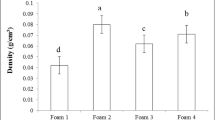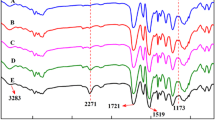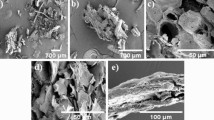Abstract
Water absorption and structure of polyurethane foam being reinforced with sawdust was conducted by comparing the structure of the foam, which were the cell wall thickness and the cell size, against the properties of the foam which was the water absorbing and retention of the foam. The reason for reinforcing the foam with the filler is because polyurethane is not a water absorbing material and by reinforcing it with filler, that is water absorbent, it will help the polyurethane to be more water absorbent. Besides, this research will also determine the changes on the mechanical properties of the polyurethane foam. The combination of Polyol and Methylene Diphenyl Isocyanate (MDI) produced the Polyurethane Foam. The filler, sawdust, was then reinforced into the mixture and left to be hardened. Once hardened, the foam underwent multiple tests such as water absorption test and water retention test. This is to determine if the property change is a positive change or a negative change. It was found that, with the increase in cell size and cell wall thickness, there was an increase in water retention of the foam. As for the cell size and wall thickness of the foam, there was a decrease in water absorption, up till a certain amount of added filler content, then the water absorption increased.
Access provided by Autonomous University of Puebla. Download conference paper PDF
Similar content being viewed by others
Keywords
1 Introduction
Polyurethane (PU) is a composite of polymer that are linked together through carbamate (urethane) joins [1]. Polyurethane is known to be a thermosetting polymer which means it would not soften easily. Therefore, polyurethane is commonly use in daily household items such as furniture, bed mattress and seating materials such as car seats and office chairs. Polyurethane is also a type of synthetic polymer that is produced by reacting monomers [2]. The monomers present contain a responding end groups which causes the diisocyanate (OCN-R-NCO) to form a reaction with the diol (HO-R-OH). It begins with having a linking between the two molecules at both ends which are reactive alcohol (OH) and reactive isocyanate (NCO). Therefore, the groups that were formed react more with other monomers hence forming a greater and lengthier molecule chain.
Sawdust, also known as wood dust, are mostly found to be the waste product of woodwork such as sanding, drilling, sawing and milling. Sawdust mostly consists of fine fragment of wood which can be sometimes lighter than dust. Moreover, sawdust consists mostly of cellulose, hemicelluloses, lignin and a small percentage of external materials. Chemical compounds also contribute to the creation of sawdust such as carbon, oxygen, hydrogen and nitrogen.
As of 2016, over 5.3 million tons of polyurethane foam were demanded to be used in furniture and has been increasing as time passes [3]. However, most polyurethane are hydrophobic and are not able to absorb water very well. Researcher Yu et al. [4] found that only 8% of water can be absorbed in comparison to the weight of the polyurethane foam. Furthermore, sawdust is disposed as a waste in timber industry, logging of trees in forest produces around 17% of sawdust [5] which is then just left on the ground.
In the past, many researchers conducted experiments to reinforce foam with fillers aimed to improve the properties of polyurethane. In Czlonka et al. [6] research on polyurethane foam reinforced with polyhedral oligomeric silsesquioxanes (POSS), it was found that the strength of the foam increased when 0.5 wt% of filler was added but decreased when anything more than 1.5 wt% of filler was added due to the uneven distribution of filler of the foam. In another research, where potato protein acted as the filler for the polyurethane foam, it was found that the by adding 0.1wt% of filler the strength of the foam increased but increasing the filler content any more caused a decrease in foam strength. This was due to the addition of filler which caused the number of closed cells to increase [7].
The main objective of this work is to investigate the effects of the incorporation of sawdust on to polyurethane on its water capabilities through image analysis. The correlation between the structural properties of the sawdust-polyurethane composite and the filler content was done in order to improve the water absorption properties of the closed-cell polyurethane composite.
2 Methodology and Experimental Setup
2.1 Preparation of Polyurethane Foam and Sawdust Filler
Polyurethane foam (PU foam) is prepared in two parts, Part A (VORACOR CD1095 Polyol which comes with a catalyst, HCFC-141b) and Part B (PAPI 27 Polymeric MDI). Both the parts are weighted separately using an electronic scale and then poured into the mixing cup. The mixture would then be allowed to rise freely at a stable condition at room temperature. The foam was left for 24 h in stable conditions to be allowed to fully form before taking any measurements and analysis and conducting any tests.
For preparation of sawdust polyurethane composite, the fine sawdust filler without surface treatment (1–4 wt%) was incorporated to the mixture of polyurethane during mixing process (Table 1). The ratio used in Part A and Part B was 1:0.65. Part A, Part B and the filler was then stirred until the mixture was fully mixed and was left for 24 h for curing to become solid state, before taking any measurements or conducting any tests.
2.2 Characterisation
Microstructure analysis
The structure of the polyurethane foam in this experiment relates to the pore size and the cell wall thickness. The sample microstructure was captured by using the Olympus BX51 at 10 × magnification. Image J software was used to determine the size of the cell and the thickness of the cell.
Water Absorption Test Characterisation
The water absorption test was conducted according to the ASTM D370 standards procedure. After that, the samples were immersed in water for 24 h and measured the mass. The water absorption was determined from the changes of mass over the pre-condition mass in percentage. Data was recorded up to 7 days.
Water Retention Test Characterisation
The same foams that were used in the water absorption test were used to conduct the water retention test. The foams samples that were immersed into water were later weighed at every 24th hour and continued being immersed in water for 7 days.
3 Results and Discussion
3.1 Cell Size and Cell Wall Thickness
The diameter of the cell and the thickness of wall were analyzed as there was a built-in measuring system in the Image J software from the microscope images of all samples as shown in Fig. 1. The PU foam cell structure was illustrated in schematic diagram Fig. 2. The cell size and wall thickness and average value obtained are shown in Table 2. It is clear that the average cell size will reduce when more sawdust filler was added into the mix. This is because the pores are generally in closed cell position. The addition of the sawdust filler into the mixture restricted the growth of foam during the expansion process, resulting in small cell size. This observation was in agreement with Czlonka et al. [6] and Lyu et al. [7], which suggested that the uneven distribution of fillers impacted the foaming process. Upon addition of sawdust filler, it was found that the strut wall thickness is reduced but then gradually increases when additional filler content was added. Such phenomena were due to fillers acting as nucleating site to promote the growth of wall thickness.
3.2 Relationship Between Cell Size and Water Absorption
Figure 3 shows a graph of the pore size against the water absorption of the polyurethane foam on 7th day. It was shown that the addition of 1 wt% and 2 wt% of the sawdust filler had caused a decrease in water absorption of around 500 percent compared to the reference sample (C). On the other hand, with the inclusion of 3%wt and 4%wt of the sawdust filler into the foam, the absorption rate of the foam increased by approximately 625 to 657 percent compared to 2 wt% sample (S2).
The water absorption of the foam had decreased for samples 0 wt%, 1 wt% and 2 wt%. This could be due to the number of closed cells because of the addition of sawdust filler. The filler behaves as a blockage that prevents most water particles from being absorbed by the foam [8]. Therefore, preventing the water particles from penetrating into the matrix of the foam thus limits the amount of water that the polyurethane foam can absorb. When the sawdust filler content increased to 3 wt% and 4 wt%, the water absorption increased to a slightly higher level than the reference sample (C). The reason behind this is due to the cell structure that is not uniform. The excess amount of filler content that causes the change to the foam structure will eventually cause the cell structure to break [9]. The change in the foam structure creates more voids in the foam, which allows for water intake of the foam.
3.3 Relationship Between Cell Size and Water Retention
Figure 4 shows the graph of the cell size against the water retention of the polyurethane foam composite. With the increase in sawdust filler content, there was an increase in the water retention of the PU foam. Thus, a quadratic function is shown in Fig. 4.
The control sample could retain the second-highest amount of water in the foam relative to other samples. This is because there was no filler in the foam, the mixture’s viscosity is low and allowing the foam to grow without any constraints. Hence, larger cells were able to form, and water can travel through the foam easily. Water increases the pore size, leading to an increase in the permeability of the foam [10]. For the foams that contained filler content, the increase in water retention could be attributed to the foam's cellular structure. The filler creates a disturbance in the cell structure, which eventually causes the cell wall to break [11]. Therefore, there is a disturbance to the foams matrix in which changes the foams forming process and eventually causing defects to the cell structure [12]. Thus, more water can be concealed in the cell structure of the foam.
3.4 Relationship Between Cell Wall Thickness and Water Absorption
Figure 5 shows the thickness of cell wall against the water absorption of the foam. It is clear that for the 0 wt%, 1 wt% and 2 wt% sawdust filler content samples, a decrease in water absorption of up to 541 percent compared to the cure sample was observed. However, for the sample with filler content of 3 wt%, an increase in water absorption is seen, similar to the reference sample (C).
When the filler content is 1 wt% and 2 wt% of sawdust filler, there was less water absorption. This can be due to the sawdust being a natural fibre. As the cell walls are symmetrical, the sawdust filler blocks the water from entering and exiting the foam. Sawdust filler acts as a blockage for the water as it is a natural fibre which has multiple layers of cellulosic microfibrils [13]. This causes water to take more time to penetrate the cell walls when moving in and out of the foam. As for the sawdust filler content of 3 wt% and 4 wt%, it was shown that there was an increase in water absorption. This could be because of the lamellae and plateau of the cell walls becoming thicker. As the walls become thicker, more irregular shapes starts to form in the foam [14] and because sawdust has hydrophilic properties [15], it will allow more water to be retained in the foam.
3.5 Relationship Between Cell Wall Thickness and Water Retention
Figure 6 shows the thickness of the cell wall against the water retention of the foam. Referring to the figure, the increase in sawdust filler from 1 wt% to 4 wt%, increases the cell wall and the water retention of the foam. A polynomial equation was shown in the Fig. 6.
The filler shown to have an increase of water retention with the cell walls increasing in size. This reasoning can be because of the fillers’ properties. Sawdust contains cellulose fibers which allows the water to stay in three areas which are the lumen of the fiber, the cell walls and the spaces between the polyurethane and the fiber [16]. Thus, with the increase in sawdust filler, there is also an increase in the three areas as confirmed by Lin et al. [17]. This will allow the foam to create more space which will allow more water to be absorbed as well as retained by the foam. The reference sample (C) was shown to retain the second highest amount of water retention compared to the rest of the samples. This can be due to the theory of the foams’ cellular structure. Since there is no presence of filler, the foam will be able to grow freely creating more open cells to be formed [18]. This allows more water to be retained in the foam due to the thick walls created by the foams’ growth.
4 Conclusion
In this study, varying amounts of sawdust filler were used to reinforce the polyurethane foam. The addition of sawdust filler have a considerable effect on the water absorption properties of the material. The study shows that with the increased amount of filler content, there is an increase of the cell wall thickness, enabling an increase in water retention of all the foams. However, this was not the case for water absorption. It was observed for the cell size that the addition of sawdust filler of 1 wt% and 2 wt% had caused a decrease in water absorption. There was an increase in water absorption rate for the samples of sawdust filler of 3 wt% and 4 wt%. Similar results were observed in the cell wall thickness against the water retention rate. The reasoning behind the observations could be due to the filler acting as a barrier that prevents water from entering the foam. With the addition of more filler (in the 3 wt% and 4 wt% samples), it causes a deformation in the foam structure, leading to water being stored in the voids created by the filler. It was suggested that no surface treatment was performed on the saw dust. The study is limited to 1–4 wt% as high filler content resulting high viscosity of the mixture and restricted the foaming process. Further work could be focus on the usage of different saw dust particle size and treated saw dust particles.
References
Chauhan NPS, Nirmala KJ, Punjabi PB, Ameta R (2015) Polyuretanes: silicone-polyurethane copolymers. https://doi.org/10.1081/E-EBPP-120050554
Polyurethane (2020) How products are made. http://www.madehow.com/Volume-6/Polyurethane.html. Accessed 14 Apr (2020)
Properties P, Production P, Market, Uses (2019) Plastic Insight. https://www.plasticsinsight.com/resin-intelligence/resin-prices/polyurethane/. Accessed 14 Apr (2020)
Yu Y-J, Hearon K, Wilson TS, Maitland DJ (2011) The effect of moisture absorption on the physical properties of polyurethane shape memory polymer foams. Smart Mater Struct 20:085010
Jenkins JH (1933) Percentage of waste resulting from the conversion of the tree into lumber in the Southeastern Coast region of British Columbia
Czlonka S, Strakowska A, Strzelex K, Adamus-Wlodarczyk A, Kairyte A, Vaitkis S (2019) Composites of rigid polyurethane foams reinforced with poss. Polym 11(336)
Czlonka S, Bertino MF, Strzelec K (2018) Rigid polyurethane foams reinforced with industrial potato protein. Polym Test 68:135–145
Lyu Y, Yu LJ, Badri KH, Zulkoffli Z, Sajuri Z, Zulkefly MZF, Tarawneg MA (2020) Characterization of biomass-reinforced biopolyol based polyurethane foams. Int J Nanoelectronics Mat 13:95–106
Członka S, Strąkowska A, Kairyte A, Kremensas A (2020) Nutmeg filler as a natural compound for the production of polyurethane composite foams with antibacterial and anti-aging properties. Polym Test 86
Fawzi T, Yu LJ, Badri KH, Sajuri Z, Al-Talib AAM, Noum SYE (2021) Sodium hydrogen bicarbonate and water as blowing agent in palm kernal oil based polyol polyurethane foam. Mater Today Proc 30:993–998
Min LY (2020) Paper pulp reinforced polyurethane growing media. UCSI Univeristy, Thesis
Gu R, Konar S, Sain M (2012) Preparation and characterization of sustainable polyurethane foams from soybean oils J Am Oil Chem Soc 2103–2111
Bledzki AK, Gassan J (1999) Composites reinforced with cellulose based fibres. Prog Polym Sci 24(2):221–274
Xue B-L, Wen J-L, Sun R-C (2014) Lignin-Based rigid polyurethane foam reinforced with pulp fiber: synthesis and characterization. ACS Sustain Chem Eng 1474–1780
Islam MN, Islam MS (2013) Characterization of chemically modified sawdust-reinforced recycled polyethylene composites. J Thermoplast Compos Mater 28(8):1135–1153
. Karmaker AC, Hoffmann A, Hinrichsen G (1994) Influence of water uptake on the mechanical properties of jute fiber-reinforced polypropylene. J Appl Polym Sci 54(12):1803–1807
Lin Q, Zhou X, Dai G (2002) Effect of hydrothermal environment on moisture absorption and mechanical properties of wood flour. J Appl Polym Sci 85(14)
Thirumal M, Khastgir D, Singha N, Manjunath BS, Naik YP (2008) Effect of foam density on the properties of water blown rigid polyurethane foam. J Appl Polym Sci
Acknowledgements
The project was supported by Lush Eco Sdn Bhd and UCSI University Research Fund (PSIF-Proj-2019- FETBE-059).
Author information
Authors and Affiliations
Corresponding author
Editor information
Editors and Affiliations
Rights and permissions
Copyright information
© 2022 The Author(s), under exclusive license to Springer Nature Singapore Pte Ltd.
About this paper
Cite this paper
Benjamin, T.J., Yu, L.J., Thomas Raymond, D.A., Lai, N.Y.G. (2022). Preparation and Water Absorption Analysis of Polyurethane Foam Reinforced Sawdust Composites. In: Abdul Sani, A.S., et al. Enabling Industry 4.0 through Advances in Manufacturing and Materials. Lecture Notes in Mechanical Engineering. Springer, Singapore. https://doi.org/10.1007/978-981-19-2890-1_31
Download citation
DOI: https://doi.org/10.1007/978-981-19-2890-1_31
Published:
Publisher Name: Springer, Singapore
Print ISBN: 978-981-19-2889-5
Online ISBN: 978-981-19-2890-1
eBook Packages: Chemistry and Materials ScienceChemistry and Material Science (R0)










